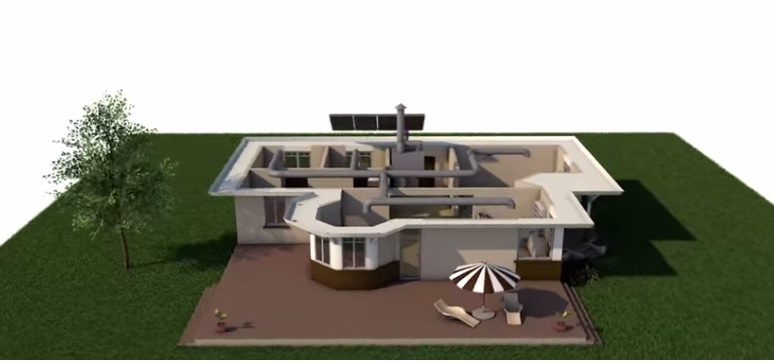Our solar cooling system is a low emissions alternative to conventional air conditioning and gas or electric powered heating, providing more comfortable homes, reduced energy bills and a cooler planet.
Over 50 per cent of the greenhouse gas emissions you produce in your home are generated by heating, air-conditioning and hot water.
A screenshot from the video (below), which explains solar cooling.
In other words keeping your home warm in winter, cool in summer with nice hot water on tap is emitting 2.5 to 5 tonnes of greenhouse gas emissions each year.
It also contributes a hefty amount to your electricity bill, between 50 to 60 per cent.
CSIRO has invented a new solar air-conditioning system for Australian homes. This technology solution will reduce Australia’s emissions, reduce your energy bills and reduce our demand for electricity and gas.
It is an innovative three-in-one technology that provides hot water, cooling and heating.
It works by using heat from the sun and employs both desiccant and evaporative cooling technologies.
Solar heat is first collected and stored as hot water, which can be used directly in the house. A portion of the hot water is diverted into the solar air-conditioning unit, which is used to either heat or cool the air coming into the building.
Emissions and electricity
Our solar air-conditioning system uses only a fraction of the electricity of current air-conditioning systems and halves greenhouse gas emissions.
We have calculated that if every home in Australia installed our solar cooling technology it would be the equivalent of saving 15 mega tonnes of CO2 or taking 3.5 million cars off the road.
Peak demand is a major issue facing energy suppliers and air-conditioning plays a strong role in generating peak demand. It is perhaps surprising to know that every $1500 air-conditioner installed imposes $7000 in costs on the energy system1.
Solar cooling air-conditioning systems are likely to be an important component of future zero emission buildings and can help reduce peak demand on the electricity grid.
The video explains how solar air-conditioning works or you.
Fast facts
- In Australia electricity usage nearly double on the hottest days due to increased demand for air conditioning.
- Solar cooling uses natural heat from the sun and so consumes much less electricity than conventional cooling systems.
- Solar cooling air-conditioning systems are likely to be an important component of future zero emission buildings and can help reduce peak demand on the electricity grid.
Extra facts
- Keeping your home warm in winter, cool in summer with nice hot water on tap is emitting 2.5 to 5 tonnes of greenhouse gas emissions each year.We have calculated that if every home in Australia installed our solar cooling technology it would be the equivalent of saving 15 mega tonnes of CO2 or taking 3.5 million cars off the road.
- Solar cooling technology is not new. In 1878, Augustin Mouchot amazed audiences and won a gold medal at Universal Exhibition in Paris for his invention which used the sun’s thermal energy to produce a block of ice.



29th August 2019 at 5:14 pm
Hi Kuberan,
Thanks for your enquiry about solar cooling technology. We are no longer conducting research in this space. For more information you may wish to contact AIRAH (https://www.airah.org.au/) or look for a commercial supplier.
Kind regards,
Kashmi
CSIRO Social Media Team
17th June 2019 at 8:52 am
There was a time when government research institutions would release their findings into the public domain and specifically tailer instructions for building their inventions for capable laypeople and mechanics in the general population, specifically farmers, ranchers, and shop enthusiasts. That era ended some time in the 1970s or 1980s. CSIRO — if you can’t find an industry partner within a year or two of inventing something useful, then you should publish your results, and publish plans for citizens to build your devices on their own. You are holding back the progress of civilization but withholding your discoveries.
11th May 2019 at 4:12 pm
Is there any update on this project?
Is is commercially available or still in development phase?
Any idea about current cost estimates?
19th September 2017 at 5:59 pm
This is a great idea. It was a great idea four years ago when it was first published. Can we please have an update as to the progress of this? Has the CSIRO found an industry partner yet? When can we see the technology in a residential application?
4th May 2017 at 2:44 am
Where do you get one?